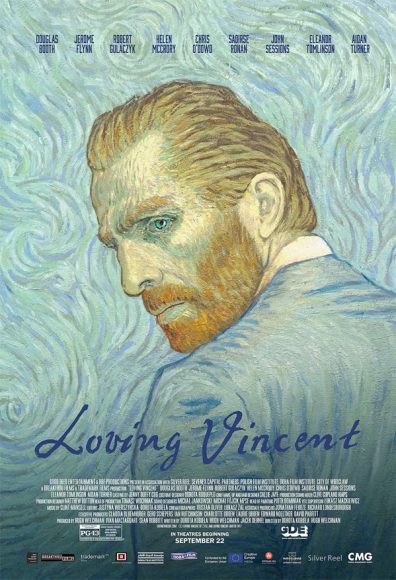
Loving Vincent movie poster. (Photo courtesy of BreakThru Productions Trademark Films)
Loving Vincent, released Sept. 22, 2017, in the U.S., is the world’s first fully-painted feature film. Originally the film was considered unique, but not worth funding. Thanks to fervent Van Gogh fans however, the movie received enough money to complete production. Those who missed out on being a part of this movie must be upset because Loving Vincent is a beautiful piece of art that is an homage to a struggling artist.
One of the most amazing parts of the movie is the dedication to the production. The movie took six years to create because the entire film was recorded using live actors and then each scene was painted by hand. This created a flip-book-like effect of 65,000 paintings in Van Gogh’s style. Both the actors and the team of over 100 artists were incredibly dedicated to this film. The love and commitment to the project emanated from the picture during the screening.
This style of production, while time-consuming, is amazing to see. The paint never sat still between frames, as each had to be individually drawn. This gave the movie a constant sense of movement and forward momentum. The color paintings are rich and impeccable representations of Van Gogh’s style. The film used 134 of Van Gogh’s original paintings, which blended in seamlessly with the newer creations. The black-and-white paintings were stunning. Because they used less of the thin lines throughout than the color paintings, they had a digitally animated feel to them. Recognizing that each of the frames was painted makes the high quality even more amazing.
At first, the artistic value of this film seems to be wasted on the plot in the movie. It focuses on Armand Roulin (played by Douglas Booth), who was friends with Van Gogh, and his journey to deliver an undeliverable letter to Van Gogh’s brother. It is quickly established that his brother, Theo (played by Cezary Lukaszewicz), passed away shortly after Van Gogh’s suicide, leaving Roulin to travel through the French countryside to meet with people Van Gogh visited before his death. What follows is a melodramatic game of he-said, she-said about why Van Gogh took his own life.
The movie faced a challenge while talking about mental health. It is well known that Van Gogh struggled with mental illness throughout his life. While no one is certain whether it was anxiety, depression or bipolar disorder, the artist was considered “eccentric” in his time because of his condition. In the 1800s, mental health wasn’t a well understood subject, and because of this people often referred to those with mental health problems in terms we couldn’t imagine using today.
Fortunately, the film was able to balance the 1800s terms of mental “imbalance” with the modern way of discussing mental health by focusing less on Van Gogh and his doctor, Gachet (played by Jerome Flynn). Because the movie dedicated much of its run time to figuring out why Van Gogh killed himself, it only made sense to end with a reason.
While the story hinted that Van Gogh felt his death would relieve a burden for many people, especially his brother, a letter at the end brought a reason to life. He wrote, “[T]he sight of stars always makes me dream … Why, I say to myself, should the spots of light in the firmament be less accessible to us than the black spots on the map of France. Just as we take the train to go to Tarscon or Rouen, we take death to go to a star … To die peacefully of old age would be to go there on foot.”
While there is some risk of legitimizing suicide, even in the case of a nearly 200-year-old artist, the movie couldn’t tell the story properly without focusing on his death. The letter at the end allows for a sense of peace because it allowed Van Gogh to be in a better place, and in a way, recall the image of the twinkling stars in A Starry Night.
Upon reflection, the plot makes perfect sense with the movie’s purpose. The title, Loving Vincent, says it all. It’s about showing how many people love the painter, even if he never knew it. It’s about celebrating the life of a great artist. The choice to focus on the people who were impacted by Van Gogh, rather than Van Gogh himself, worked in harmony with the choice to paint the movie in his style. The entire piece was a tribute to honor the artist by showing the impact he had on people in his time, people in our time and the entire artistic community.
It is disappointing that it is only playing for a short time in select theaters around the country because it is an amazing film. It allows one to learn more about and to celebrate the life of a revolutionary painter — and simply because of the incredible artistic production. This is a movie worth the price of admission.
Loving Vincent is playing in Denver and Boulder for the rest of the week. Get tickets here.
You can contact Art Editor Stephanie Wood at stephanie.a.wood@colorado.edu.
